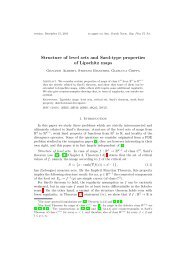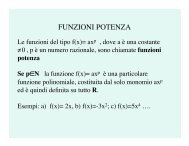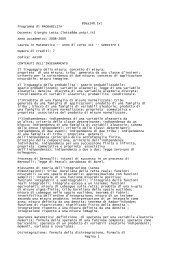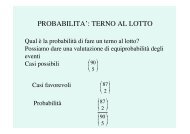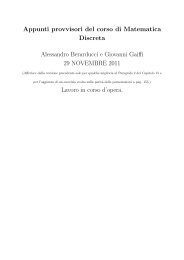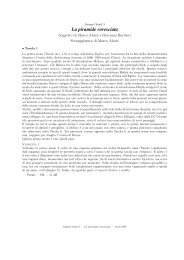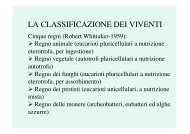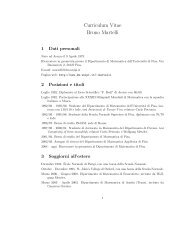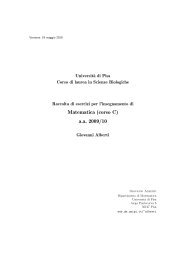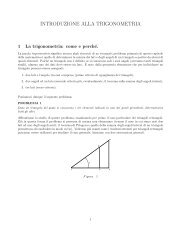Immersioni aperte in dimensione infinita - Dipartimento di Matematica
Immersioni aperte in dimensione infinita - Dipartimento di Matematica
Immersioni aperte in dimensione infinita - Dipartimento di Matematica
You also want an ePaper? Increase the reach of your titles
YUMPU automatically turns print PDFs into web optimized ePapers that Google loves.
86 Intorni tubolari<br />
una sezione <strong>di</strong> T M su N è della forma (ζ, ν), <strong>in</strong> cui ζ ∈ T (N) è una sezione <strong>di</strong> T N, i.e. un campo<br />
<strong>di</strong> vettori su N, e ν è un campo normale, cioè una sezione del fibrato normale N (N).<br />
D.2 Fibrati comprimibili<br />
Introduciamo l’importante nozione <strong>di</strong> fibrato comprimibile. Come vedremo fra poco, essa risulterà<br />
utile quando <strong>in</strong>dagheremo le proprietà degli <strong>in</strong>torni tubolari.<br />
Def<strong>in</strong>izione D.2. Un fibrato vettoriale π : X → M (cfr. def<strong>in</strong>izione C.30) è detto comprimibile<br />
se, dato comunque un <strong>in</strong>torno aperto V della sezione nulla, ζ(M) ⊂ V ⊂ X, esiste un aperto<br />
ζ(M) ⊂ V1 V1 V1 ⊂ V , ed un <strong>di</strong>ffeomorfismo <strong>di</strong> classe C∞ <strong>di</strong> X su V1, ϕ: X −→ V1, tale che il seguente<br />
<strong>di</strong>agramma sia commutativo:<br />
X <br />
ϕ<br />
<br />
V1<br />
<br />
π<br />
π <br />
<br />
|V1<br />
<br />
<br />
M<br />
Nel caso particolarissimo <strong>in</strong> cui la varietà M base del fibrato sia ridotta ad un s<strong>in</strong>golo punto,<br />
e qu<strong>in</strong><strong>di</strong> lo spazio totale X sia uno spazio <strong>di</strong> Banach E, la def<strong>in</strong>izione D.2 asserisce che E è C ∞ -<br />
<strong>di</strong>ffeomorfo ad <strong>in</strong>torni arbitrariamente piccoli dell’orig<strong>in</strong>e O ∈ E, fatto sempre vero per gli spazi <strong>di</strong><br />
Hilbert, ma problematico per gli spazi <strong>di</strong> Banach.<br />
Def<strong>in</strong>izione D.3. Sia M una varietà, e σ : M → R + una funzione cont<strong>in</strong>ua. Sia π : X → M un<br />
fibrato <strong>di</strong> Hilbert su M. Denoteremo con X(σ) il sotto<strong>in</strong>sieme <strong>di</strong> X costituito dai vettori v tali che,<br />
se v appartiene a Xp, allora<br />
|v | p < σ(p).<br />
In particolare, X(σ) è un <strong>in</strong>torno aperto della sezione nulla.<br />
Proposizione D.4. Sia M una varietà e π : X → M un fibrato <strong>di</strong> Hilbert. Se σ : M → R + è una<br />
funzione cont<strong>in</strong>ua, allora la mappa<br />
w ↦−→<br />
è un <strong>di</strong>ffeomorfismo <strong>di</strong> classe C ∞ <strong>di</strong> X su X(σ).<br />
Dimostrazione. Ovvia, la mappa <strong>in</strong>versa essendo<br />
v ↦−→<br />
σ(πw) w<br />
<br />
1 + |w | 21/2 v<br />
[σ(πv)] 2 − |v | 2 1/2 .<br />
Corollario D.5. Siano M una varietà che ammetta partizioni dell’unità e π : X → M un fibrato<br />
<strong>di</strong> Hilbert su M. Allora X è comprimibile.<br />
Dimostrazione. Sia Z un <strong>in</strong>torno aperto della sezione nulla. Per ogni p ∈ M, esiste un <strong>in</strong>torno aperto<br />
Vp <strong>di</strong> p ed un numero reale strettamente positivo ap tale che i vettori <strong>in</strong> π−1 (Vp) aventi lunghezza<br />
m<strong>in</strong>ore <strong>di</strong> ap appartengono a Z. Sia {(Ui, ϕi)} una partizione dell’unità su M subord<strong>in</strong>ata a {Vp}p:<br />
ciò significa <strong>in</strong> particolare che per ogni i esiste p = p(i) tale che Ui ⊂ Vp(i). Inf<strong>in</strong>e, sia σ la funzione<br />
def<strong>in</strong>ita ponendo<br />
σ(p) : def<br />
= ap(i) ϕi. Allora X(σ) è contenuto <strong>in</strong> Z, e l’asserto segue dalla proposizione D.4.<br />
IMMERSIONI APERTE IN DIMENSIONE INFINITA



